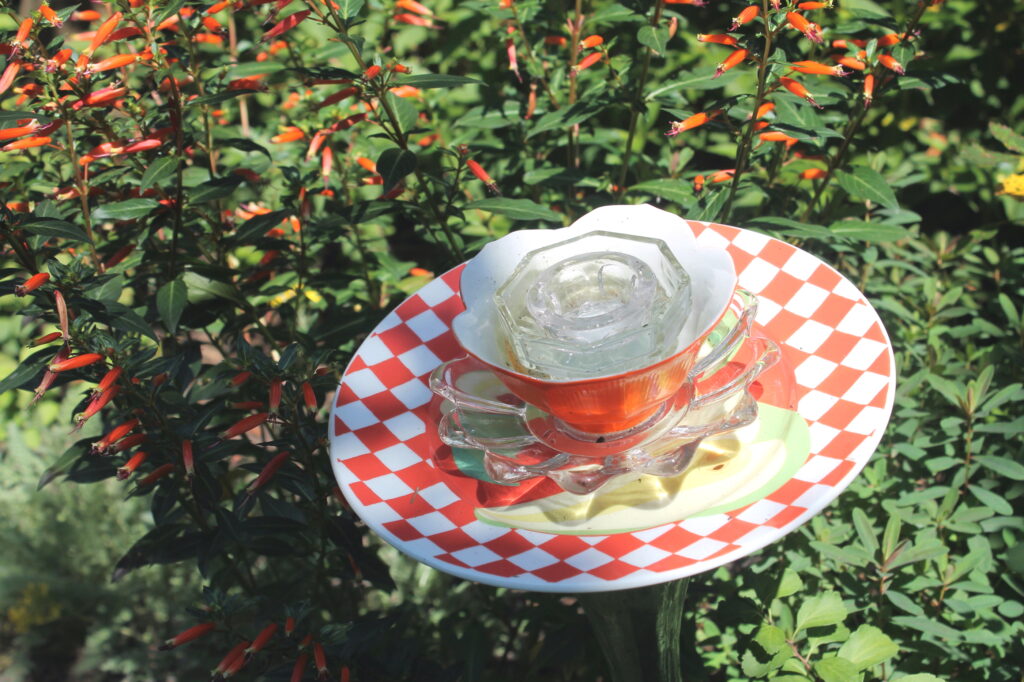![]() Gardening can give a second life to all sorts of household junk, er, “resources.” Here are 20 re-tooling possibilities:
Gardening can give a second life to all sorts of household junk, er, “resources.” Here are 20 re-tooling possibilities:
1.) Old shoes, baskets, backpacks, pocketbooks, etc. Just about any worn-out item that’ll hold soil can morph into a plant container. Just be sure it has drainage holes.

2.) Vinyl blinds, plastic detergent bottles. Cut in strips with a point at one end and use as plant labels. Use a china marker or wax pencil for writing.

3.) Old nylons. Cut them into strips to make soft ties for tomato plants, for staking new trees, or for securing any tall, floppy vine or plant to a support.
4.) Old shirts. Besides transforming into rags, these can be cut into strips and also used as soft plant ties.

5.) Dishes, glassware, vases, ceramics. Old, one-off, and even cracked dishes and such can be crafted into garden ornaments.

6.) Kitchen scraps. Banana and vegetable peels, eggshells, coffee grounds, salad remnants, and other organic food waste make ideal “fuel” for the compost pile along with yard waste such as leaves, spent plants, and grass clippings.
7.) Newspaper, junk mail, office paper. All can be shredded and added to the compost pile.
8.) Old carpet. Cut it into strips and lay on the ground as a weed-preventing mulch between rows in the vegetable garden.
9.) Empty milk jugs. Wash and reuse as plant protectors over young veggie-garden plants on cold nights. Or use the cut-off bottoms as seed-starting containers.
10.) Plastic soda bottles. Cut a vertical slit and wrap the bottles around young trees, shrubs, and vines to protect them against rodent chewing.
11.) Margarine tubs, yogurt cups, egg cartons. Poke holes in the bottom and use as seed-starting containers.
12.) Foam meat trays. These make excellent water-catching trays for homemade seed-starting containers or for growing seedlings in cell packs that you’ve cleaned and recycled from previous plant purchases.
13.) Plastic wrap. After food-bowl duty, save a few sheets to drape over seed-starting trays. It traps moisture like a mini-greenhouse.
14.) Window cleaner spray bottles. Rinse them well and use to mist seed trays or tip cuttings. Or use them for spraying animal repellents.
15.) Mayo jars. Cleaned well, these make ideal storage containers for saved seeds in the refrigerator.
16.) Aluminum foil, cardboard tubes from toilet-paper and paper-towel rolls. Wrap around the base of squash-family plants to keep squash-vine borers from laying eggs at the base of plants.
17.) Used sandpaper. Staple strips of it to the tops of raised-bed boards or other wooden-bed edging to repel slugs, which detest crawling over scratchy surfaces.
18.) Old mailbox. Relocate it to the garden, where it can become a repository for markers, labels, string, and all of those other little things you forget from the garage.
19.) Old broomstick, left-over PVC pipe. Make your own watering wand for reaching hanging baskets and window boxes by using metal hose clamps to secure your garden hose to them.
20.) Dehumidifier water. Save on the water bill by using water from dehumidifiers on houseplants or outdoor potted plants.
This article is a web exclusive story that is an extension of the 2024 Annual Gardening Guide on how to save money in the garden. Find the full March feature, Digging for Dollars, here.


